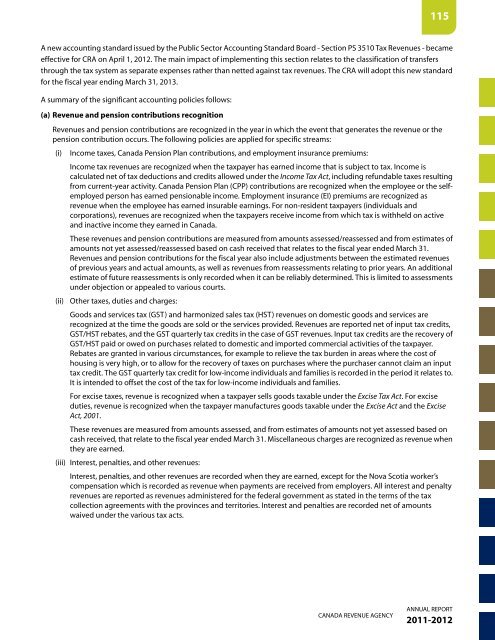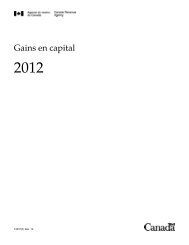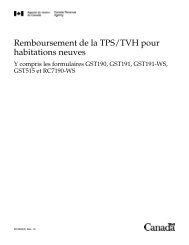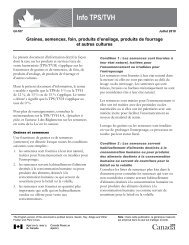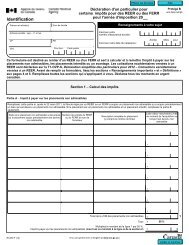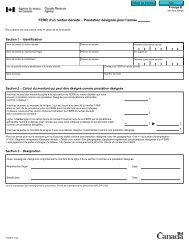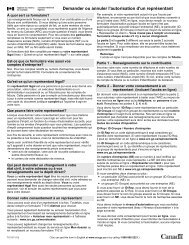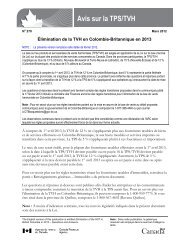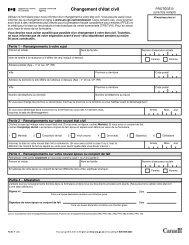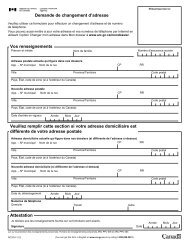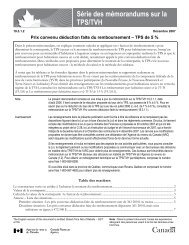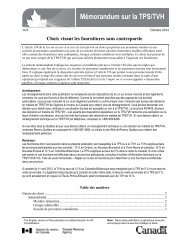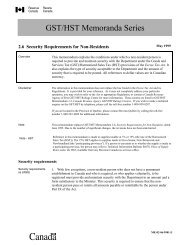CRA Annual Report to Parliament 2011-2012 (PDF - Agence du ...
CRA Annual Report to Parliament 2011-2012 (PDF - Agence du ...
CRA Annual Report to Parliament 2011-2012 (PDF - Agence du ...
Create successful ePaper yourself
Turn your PDF publications into a flip-book with our unique Google optimized e-Paper software.
A new accounting standard issued by the Public Sec<strong>to</strong>r Accounting Standard Board - Section PS 3510 Tax Revenues - became<br />
effective for <strong>CRA</strong> on April 1, <strong>2012</strong>. The main impact of implementing this section relates <strong>to</strong> the classification of transfers<br />
through the tax system as separate expenses rather than netted against tax revenues. The <strong>CRA</strong> will adopt this new standard<br />
for the fiscal year ending March 31, 2013.<br />
A summary of the significant accounting policies follows:<br />
(a) Revenue and pension contributions recognition<br />
Revenues and pension contributions are recognized in the year in which the event that generates the revenue or the<br />
pension contribution occurs. The following policies are applied for specific streams:<br />
(i) Income taxes, Canada Pension Plan contributions, and employment insurance premiums:<br />
Income tax revenues are recognized when the taxpayer has earned income that is subject <strong>to</strong> tax. Income is<br />
calculated net of tax de<strong>du</strong>ctions and credits allowed under the Income Tax Act, including refundable taxes resulting<br />
from current-year activity. Canada Pension Plan (CPP) contributions are recognized when the employee or the selfemployed<br />
person has earned pensionable income. Employment insurance (EI) premiums are recognized as<br />
revenue when the employee has earned insurable earnings. For non-resident taxpayers (indivi<strong>du</strong>als and<br />
corporations), revenues are recognized when the taxpayers receive income from which tax is withheld on active<br />
and inactive income they earned in Canada.<br />
These revenues and pension contributions are measured from amounts assessed/reassessed and from estimates of<br />
amounts not yet assessed/reassessed based on cash received that relates <strong>to</strong> the fiscal year ended March 31.<br />
Revenues and pension contributions for the fiscal year also include adjustments between the estimated revenues<br />
of previous years and actual amounts, as well as revenues from reassessments relating <strong>to</strong> prior years. An additional<br />
estimate of future reassessments is only recorded when it can be reliably determined. This is limited <strong>to</strong> assessments<br />
under objection or appealed <strong>to</strong> various courts.<br />
(ii) Other taxes, <strong>du</strong>ties and charges:<br />
Goods and services tax (GST) and harmonized sales tax (HST) revenues on domestic goods and services are<br />
recognized at the time the goods are sold or the services provided. Revenues are reported net of input tax credits,<br />
GST/HST rebates, and the GST quarterly tax credits in the case of GST revenues. Input tax credits are the recovery of<br />
GST/HST paid or owed on purchases related <strong>to</strong> domestic and imported commercial activities of the taxpayer.<br />
Rebates are granted in various circumstances, for example <strong>to</strong> relieve the tax burden in areas where the cost of<br />
housing is very high, or <strong>to</strong> allow for the recovery of taxes on purchases where the purchaser cannot claim an input<br />
tax credit. The GST quarterly tax credit for low-income indivi<strong>du</strong>als and families is recorded in the period it relates <strong>to</strong>.<br />
It is intended <strong>to</strong> offset the cost of the tax for low-income indivi<strong>du</strong>als and families.<br />
For excise taxes, revenue is recognized when a taxpayer sells goods taxable under the Excise Tax Act. For excise<br />
<strong>du</strong>ties, revenue is recognized when the taxpayer manufactures goods taxable under the Excise Act and the Excise<br />
Act, 2001.<br />
These revenues are measured from amounts assessed, and from estimates of amounts not yet assessed based on<br />
cash received, that relate <strong>to</strong> the fiscal year ended March 31. Miscellaneous charges are recognized as revenue when<br />
they are earned.<br />
(iii) Interest, penalties, and other revenues:<br />
Interest, penalties, and other revenues are recorded when they are earned, except for the Nova Scotia worker’s<br />
compensation which is recorded as revenue when payments are received from employers. All interest and penalty<br />
revenues are reported as revenues administered for the federal government as stated in the terms of the tax<br />
collection agreements with the provinces and terri<strong>to</strong>ries. Interest and penalties are recorded net of amounts<br />
waived under the various tax acts.<br />
CANADA REVENUE AGENCY<br />
115<br />
ANNUAL REPORT<br />
<strong>2011</strong>-<strong>2012</strong>


